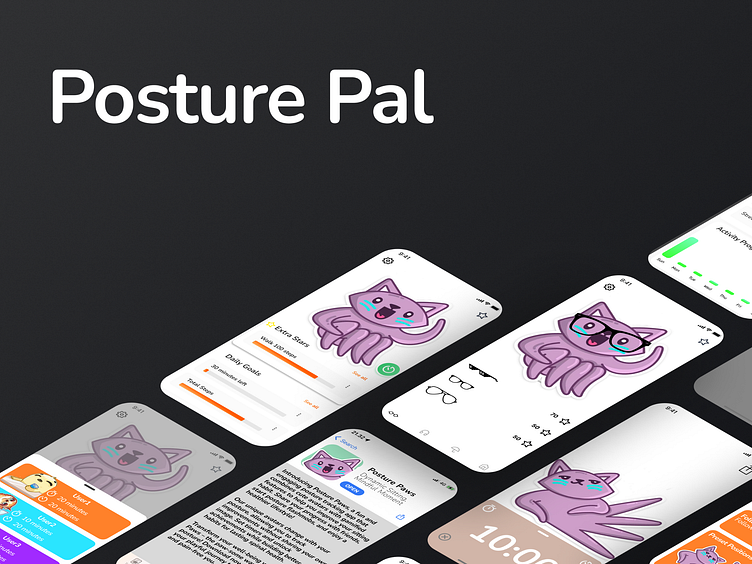Posture Pal
Designing a gamified application to motivate a better sitting posture.
Project Overview
This study utilized the research through design method to explore ways of improving posture-tracking mobile health applications by integrating gamification elements. The aim was to create a system that would motivate users to maintain good posture and keep them engaged over time. The design process included an exploration of the literature and existing applications for maintaining good posture, a co-design workshop to gather inspirational insights and a prototype refinement. The study tested the application prototype by having six gamification experts try it out and gathered feedback through questionnaires. The study offers ideas for further development and serves as a guide for designing similar gamified systems like Posture Paws.
Research and Concept Development
After reviewing relevant theoretical literature, the following design intents (DI) have been identified to create an effective and engaging application that promotes better sitting posture:
DI-1. Promote principles of posture variation. Encourage users to change their posture or take microbreaks during prolonged sitting.
DI-2. Consider habit-promoting tips by Harvey et al. (2022) through usage of strategies such as setting goals, creating routines, creating a structured environment that supports healthy habits and providing positive feedback to help users to develop new, healthy habits.
DI-3. Integrate Punk Gamification principles, by means of increasing the freedom of the users to define the rules for their gamification experience.
Prototype Design and Development
The co-design workshop was aimed to support the ideation of the gamification process. Consider exploring the motivators and challenges faced by users with experienced gamification designers and researchers. Therefore, the “Co-design workshop to design a gamification to motivate office workers for a better posture” was organised to brainstorm together with experts in gamification from the Gamification Group at Tampere University.
The insight and inspiration gained during the co-design workshop provided me with many interesting design solutions that potentially could be used during the Design phase. From these design suggestions that arose, it was possible to extract four clusters of the most interesting design approaches. These approaches have different ways to boost users' motivation and provide user engagement and habit change. Hence, the gamified application for a better posture habit will be designed based on the identified cluster or a combination of them, and afterwards evaluated with potential users and experts.
User Testing
I organised a small assessment session where the participants (n=6) interacted with a simple prototype and got acquainted with the whole concept of my application through the sequential execution of various tasks. To create a simulation of the user experience of the application, I employed the Wizard of Oz research method (Kelley, 1984), which is a type of research methodology where participants interact with a simulated interface that is controlled by a human instead of a computer program. After the assessment participants were invited to participate in a short debriefing where they had the possibility to offer verbal comments. The questionnaire contained items from the UEQ (User Experience Questionnaire) and GAMEFILQUEST (Gameful Experience Questionnaire) to assess the prototype's user experience and perceived gamefulness, to serve as a foundation for further observation and discussion of the research.
Outcomes and Design Recommendations
Through the exploration of the design process and the reflections inspired by the final assessment, I have gained insights that have led me to formulate a set of design considerations that can support the future development of apps or other motivational systems promoting habit forming for posture health and possibly to the mhealth field in general:
Posthuman avatars. One of the key design considerations that emerged from my research is the importance of using animal -or non-human- avatars that resonate with users and allow them easier identification instead of human avatars that may contain normative ideologies in them of gender race etc. Such avatars seemed to also encourage participants to mimic certain posture positions. In particular, participants responded positively to non-traditional animals and appreciated the addition of unique features, such as extra limbs. However, designers should be careful not to limit users' options by providing only binary gender choices for avatars. Instead, it is recommended to offer gender-neutral options that allow users to customize their avatars as they see fit.
Embedded playfulness. In the context of a project focused on dynamic postures, the aesthetics of the application are as crucial as the user's interaction with the technology. If the prototype does not technically support playful behaviour, static images can still be effective in conveying the intended message and still was perceived as playful, which helped to overcomethe technical deficit and motivated participants to focus on their posture habits.
Rely on expertise. Although not all participants expressed confusion regarding the freedom in the therapeutic application, it is crucial to take into account the participants who already experience posture-related problems and the potential negative consequences that may arise. Therefore, I believe it is necessary to involve medical specialists in the development of the application to minimize the risk of any harmful consequences.
Beware the panopticon. Developing a prototype that tracks posture without any sensing technology might be difficult as users may feel distrustful of being monitored. Therefore, it is important to either create a prototype that assures users that it does not collect their data and uses sensing technology purely to communicate playfulness or explore alternative ways of addressing posture issues.

